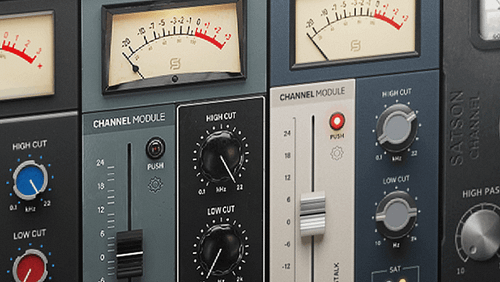Digital data is information represented by a string of discrete binary digits. All the information, graphics, and audio in our computers are encoded by these strings of zeros and ones. They are just like construction blocks that sit one next to the other inside our hard drives. Unless the computer processing combines them, there is no interaction between them. That means that when we record audio in our DAW, once the analog signal gets digitized there is no interaction between the audio files. They playback independently, in sync with each other, and we are able to combine them into new waveforms thanks to the capabilities of the software — but that didn’t use to be the case.
Back in the day, studios only worked with analog equipment. Analogue recordings rely on the physics of how electricity works. During the recording, sound from instruments was translated into AC current, thanks to microphones. That signal was stored in tape by the changes of the magnetic field caused by electricity flow. Then, during playback, tape machines turned those magnetic changes back into electricity. And finally, all the audio signals were mixed together in a console to get our favourite music printed on another tape. Change tape for computers and it should be a very similar process to what happens nowadays. Or is it?
As we mentioned before, electricity flow creates a magnetic field, which at the same time induces electricity. So, what happens in every step in between the recording? Which signals travel through cables, consoles, EQs, and compressors? Simple. Everything affects everything else through a process called crosstalk. But how does crosstalk work and how can it benefit our mixes? Let’s find out.
What is Crosstalk?
In technical terms, crosstalk is any phenomenon by which a signal transmitted on one electric circuit creates an effect in another circuit. It is inevitable and inherent in analogue systems and can be minimised by carefully designing the circuitry and creating good wiring arrangements. Crosstalk can occur in all types of electronic setups. It is expressed as a ratio and it is typically stated in decibels.
When we talk about crosstalk in audio, it refers to signal leakage across from one channel of the stereo field to another. Crosstalk is also frequency-dependent, generally getting stronger at higher frequencies. Complex circuit layouts found in audio processing devices often result in different values in the two directions of the crosstalk. This means that the crosstalk from the right channel to the left channel is often not identical to crosstalk in the other direction.
Crosstalk in Analog Mixes
Stereo compressors, equalizers, tape recorders, and many other devices are all susceptible to crosstalk and it can be even more noticeable in mixing consoles.
Crosstalk can affect the stereo image and width of our audio. If it is in phase, it tends to reduce the image width, but if it’s out of phase it will widen it. That’s what is referred to as depth and three-dimensionality when mixing in an analog console.
When mixing in digital — since there is no bleeding between the data of each channel — this effect is lost. But with modern audio processing, we are able to emulate crosstalk from different gear straight into our sessions.
Satson, Britson and Satson CS
Sonimus has brought crosstalk features into its line of console emulations and channel strip plugins, including Britson, Satson, and Satson CS.
In Britson and Satson you can find crosstalk in the stereo Bus component, while in Satson CS it is engaged in every stereo instance of the plugin. This feature emulates the effect that would happen as the signal passes through a stereo bus, with the flexibility of choosing between two different circuits: Vintage (engaged by default in the console emulations) or Modern (by default in Satson CS). By clicking on the logo or crosstalk text you can change the crosstalk mode or disengage it completely for more transparent processing.
This kind of feature is great to recreate the process of mixing in an analog console and get that sense of depth in your tracks — all happening inside your DAW. Use Satson or Britson Buss on your Summing busses, Aux tracks, effects, and Master bus to bring your mixes alive. And if you use Satson CS as your main mixing plugin you’ll get an instant analog vibe on each track you use it on.
Written By Carlos Bricio
Did you know about crosstalk? Do you take advantage of it in your mixes? Let us know in the comments below, follow us on our socials, and subscribe to our newsletter to get the latest articles from Sonimus’ blog.







Leave A Comment
You must be logged in to post a comment.